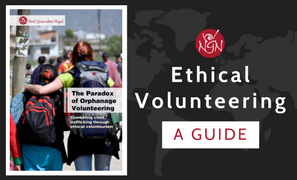Orphanage Trafficking and Child Protection in Emergencies in Nepal: A Comparative Analysis of the 2015 Earthquake and the 2020 COVID-19 Pandemic
This article compares and contrasts two humanitarian emergencies and their impact on Nepal: these are the Nepal earthquake in 2015 and the COVID-19 pandemic in 2020. It explains how each emergency has impacted children without parental care or at risk of family separation, with specific reference to orphanage trafficking, voluntourism, child institutionalisation and family preservation. In relation to each emergency, the article considers the role of disaster preparedness; the roles of the Nepal government, the international community and civil society; and the significance of one emergency being localised, while the other is a global phenomenon. It also shows that while these emergencies have increased the risk of harm and exploitation for children and families, they have also driven forward innovation in child protection practices, particularly through the use of reintegration, case management and family preservation programmes.
Introduction
This article compares and contrasts two humanitarian emergency situations and their impact on Nepal: these are the Nepal earthquake in 2015 and the COVID-19 pandemic in 2020. It considers how each emergency has impacted children without parental care or at risk of family separation, with particular reference to orphanage trafficking, voluntourism and child institutionalisation. It also considers how well actors working towards family-based care solutions for children were prepared for each emergency and how well they have been able to adapt and respond. It argues that while humanitarian emergencies in Nepal have increased the risk of harm and exploitation for children and families, these emergencies have also helped to drive forward innovation in child protection and anti-trafficking work.
The article draws on 15 years’ operational experience of the US international NGO, Next Generation Nepal (NGN), which began tackling orphanage trafficking in Nepal in 2005. It draws on NGN’s internal programme and case records, as well as external sources. The co-authors of this article have both been active players in NGN’s work. The principle author was the Country Director of NGN between 2012 and 2016, during which time he pioneered the movement in Nepal to raise awareness of the links between child institutionalisation, trafficking and voluntourism. He also oversaw NGN’s 2015 earthquake response and continues to remain involved as NGN’s strategic adviser. The co-author began supporting NGN as a reintegration officer in 2009. In 2015, he oversaw the implementation of NGN’s earthquake response project; in 2016, he was appointed as NGN’s country director; and in 2020, he led NGN’s COVID-19 response.
The article begins by outlining the context of orphanage trafficking in Nepal. Second, it explains the impact of the Nepal earthquake and COVID-19 pandemic on Nepal and considers how NGN and other child protection agencies responded. Finally, it concludes with a comparative analysis of the two emergencies and considers what can be learnt to improve child protection in emergency response in Nepal in the future.
Context
The roots of orphanage trafficking in Nepal go back to the 10-year civil conflict between 1996 and 2006 (Punaks & Feit, 2014a). During this time, many children from Humla district were displaced from their families by traffickers who placed them in exploitative institutional care in Kathmandu. When the conflict ended in 2006, orphanage trafficking evolved further and spread across Nepal. Traffickers took advantage of the aspirations of poor and uneducated families who wanted their children to experience better material living conditions and receive an education, but in many institutions, the children were exploited as poverty commodities. Initially, this was mainly oriented around the corrupt inter-country adoption system.1 However, following the 2010 embargo on inter-country adoptions, the business model pivoted to target well-intentioned foreign volunteers and donors who were persuaded to financially support children’s homes and ‘orphanages’, believing the children to be orphans or destitute. In fact, up to 85% of the children had living parents. Children would often be forced to lie about their origins and identity; denied access to their families and communities; emotionally, physically and sexually abused; and sometimes denied access to proper care as a deliberate strategy to incentivise donations. NGN formally documented this process in 2014 (Punaks & Feit, 2014a, 2014b), and it started a campaign to raise awareness of it (Punaks, 2016a). In 2017, the phenomenon was recognised by the US government as a form of trafficking in Nepal in the Trafficking in Persons Report (Department of State, 2017) and is now the subject of campaigns by many organisations globally.2
NGN’s work to address these issues began towards the end of the Nepal conflict in 2005. It introduced a family tracing and case management approach to remove children from abusive institutions and reintegrate them with their families (Grennan, 2011; Lovera & Punaks, 2015). NGN continues to undertake this work in close collaboration with the Government of Nepal, and it has trained other organisations to replicate its approach. While NGN’s approach was developed in response to child displacement during a humanitarian emergency (the civil conflict), NGN is not a humanitarian organisation and normally only operates as a development NGO. However, during both the Nepal earthquake in 2015 and the COVID-19 pandemic in 2020, it adapted its approach to these emergency contexts.
NGN’s approach aligns with child protection best practice. The UN Convention on the Rights of the Child (UN Commission on Human Rights, 1990) and Guidelines for the Alternative Care of Children (UN General Assembly, 2010) call for children to grow up in family-based care, wherever possible, to support their physical, emotional and development needs. The recent UN Resolution on the Promotion and Protection of Rights of the Child (UN General Assembly, 2020) also supports these principles and stresses the importance of strengthening families to achieve these. Furthermore, the Resolution recognises practices akin to orphanage trafficking and the harm caused by orphanage volunteering and tourism. Child protection best practice similarly supports family preservation in emergency contexts (Interagency Working Group on Unaccompanied and Separated Children, 2013; International Committee of the Red Cross, 2004). These international instruments and principles are underlined by 80 years of research, which evidence the harm of institutional care and advocate for family-based care (Berens & Nelson, 2015; Lyneham & Facchini, 2019; Van IJzendoorn et al., 2020).
Nepal Earthquake 2015
On 25 April and 12 May 2015, Nepal was hit by earthquakes measuring 7.8 and 7.3 on the Richter scale, respectively. These were followed by hundreds of aftershocks as well as landslides, food insecurity, loss of shelter, disease, gender-based violence, failure of crops and livelihoods, and other threats to vulnerable communities. A total of 9,000 people were killed and 22,000 were injured. These conditions created a secondary humanitarian child protection emergency.
Following the earthquakes, an outpouring of international sympathy for Nepal resulted in many foreign donors scoping for suitable projects to support the country’s recovery. Children’s projects—‘orphanages’ in particular—were able to make a compelling case for support (Hodge, 2015; Limaye, 2015). During multi-stakeholder child protection meetings held in May 2015, led by the government’s Central Child Welfare Board, civil society organisations advocating for institutional care made a strong case that it was necessary—and claimed they had the resources—to move children from affected communities to Kathmandu to temporarily institutionalise them for their own ‘protection’. Some institutions began to directly fundraise to support ‘earthquake orphans’ on social media. NGN also began to receive reports of traffickers posing as aid-workers, targeting affected communities to recruit children to be placed in institutions in Kathmandu. This was despite the fact that there were only 176 children recorded as being fully orphaned (having lost both parents) by the earthquakes (Central Child Welfare Board, 2015), and very few, if any, cases of orphans being unaccompanied. Similar to the Nepal conflict of 1996–2006, a surge in orphanage trafficking looked increasingly likely.
In response to this, NGN (Feit, 2016) and UNICEF (2015) released public statements in May and June, warning of the risks of an increase in child institutionalisation and trafficking, and asking international donors and volunteers not to support institutions and instead support efforts to keep families together. The Government of Nepal passed a directive only allowing children to cross district borders with their parents or with written government approval. prohibiting children from being admitted to or moved between childcare homes and prohibiting new childcare homes being established (UNICEF, 2015). This was a significant step in establishing a rigorous gatekeeping system for the new high-risk environment.
NGN further built on these developments by establishing a Community Anti-Trafficking (CAT) Project with an objective to promote family preservation and prevent an increase in child institutionalisation. Its main activities were:
- Child-friendly spaces: Large tents were erected for at-risk communities providing safe child day care as a form of respite for parents and families struggling to rebuild their livelihoods. They also provided psychosocial support, play activities, education and healthy food. These activities allowed NGN to monitor and prevent family separation and also build trust with communities to open the door for sensitisation activities.
- Police check-posts: Anti-trafficking check-posts at busy road junctions were managed by police with support from NGN to enforce the government’s gatekeeping directives. Check-post monitors stopped and searched vehicles for children being transported without their parents or the necessary government paperwork. In addition to directly intercepting children being trafficked, this activity had a powerful deterrent effect.
- Community sensitisation: Anti-trafficking and family preservation advocacy messages were disseminated to at-risk communities using pictorial leaflets and posters3, ‘corner meetings’, radio broadcasts and a travelling street drama (Next Generation Nepal, 2016).
- Local monitoring: Building on the trust developed with communities, NGN monitored the situation on the ground to assess and adapt its activities to the evolving nature of orphanage trafficking.
- International advocacy: NGN engaged with the international media and civil society to influence well-wishers to dissuade them from financially supporting or volunteering in ‘orphanages’ (Moran & Jesko, 2015; Smith, 2016).
After a year of running the CAT Project, NGN had directly supported 1,400 at-risk children through child-friendly spaces, intercepted 77 at-risk children at police check-posts and reunified them with their families, and reached over 46,000 families through sensitisation activities (Punaks, 2016b). An external evaluation showed that the project had been successful in meeting its objectives (Bennett, 2016). Indeed, while there was unfortunately no baseline data to compare against the pre- and post-earthquake periods, there was fortunately no evidence to suggest that the much anticipated surge in orphanage trafficking occurred. This was arguably due to the efforts of child protection and anti-trafficking organisations—including NGN—in curbing this.
COVID-19 Pandemic 2020
COVID-19 was first reported in China in November 2019, although it was not until early 2020 that its significant threat to global health became apparent. It was only in early March 2020 that Nepal began to put in place restrictions against international travel, followed by a national lockdown on 24 March.
To understand how child protection actors responded to the COVID-19 pandemic, it is important to briefly reflect on the changed political context in Nepal since 2015. The Constitution of Nepal, 2015, created a federal system of government with three tiers of administration at the local, provincial and central levels. As had been the intention behind this model, democracy and power has shifted away from the centre and moved towards local governments, including the oversight of child protection (Bhattarai, 2019). Furthermore, a new Children’s Act, 2018, was passed, which encourages the reintegration of children from institutions and establishes a National Child Rights Council (NCRC) with a mandate to implement the provisions in the Act (Government of Nepal, 2018, section 54). While local child welfare authorities are yet to be formally appointed—as per provisions in the Children’s Act—Child Protection Committees led by members of local governments have been mandated to deal with child protection issues. NGN’s experience has shown that local mayors and chairpersons have become increasingly active in the local child protection space, both through their welcoming of civil society actors to operate in these areas and through their enthusiasm to cooperate with and support them. Prior to the changes brought about by federalism and the Children’s Act, this had not been the case (due to local government structures having limited powers and capacity).
On 14 March 2020—10 days before the national lockdown—NCRC issued a public statement instructing childcare homes to reintegrate children with their families (Bhushal, 2020). In response to this, NCRC reported that 141 children from 38 childcare homes were reunified with their families (National Child Rights Council, 2020). In the months following this, NCRC reported that a further 1,362 children ‘have gone home due to Covid’ (National Child Rights Council, 2020). When we consider that prior to the COVID-19 pandemic, there were 15,565 children living in childcare homes in Nepal (Shrestha, 2020), this would suggest that in the early stages of the pandemic, nearly 10% of institutionalised children in Nepal returned to their communities. However, it is important to note that this rapid deinstitutionalisation process occurred mostly without proper assessments, preparation or case management of the children, as would be considered good child protection practice to ensure safe and sustainable reintegration. Concerns were raised about this to the NCRC at a Child Protection Working Group4 meeting in August 2020. The same working group also published a paper making recommendation to resolve the issue, which was formally submitted to the NCRC (Child Protection Working Group, 2020). To date, there is limited information available as to the status of these children.
A further concern for child protection actors in Nepal related to the socio-economic impact of the 5-month national lockdown on children and families. Early findings suggest that this has had a significant and detrimental effect on families’ livelihoods; farming practices; debt levels; food security and dietary intake; access to water for drinking, washing and cooking; access to essential goods like medicines and soap; access to social protection payments; access to children’s education; domestic violence levels; and mental health, including suicide rates (Mahato et al., 2020; Poudel & Subedi, 2020; UNICEF, 2020). Global evidence shows that these sorts of declining socio-economic conditions can too easily become driving factors towards an increase in institutionalisation (Better Care Network, 2020) and child trafficking (Anti-Slavery International, 2020).
In this context, NGN’s emergency response to the COVID-19 pandemic, to prevent a rise in orphanage trafficking, was to amplify and adapt its approach to case management of reunified children, to ensure their placements with families remained safe and sustainable. This was, however, not without significant challenges due to lockdown restrictions on movement. NGN’s solution to this was to pivot from its traditional approach of face-to-face case management and the provision of financial and material family support, to running these activities remotely. In the past, prospects for remote case management had been restricted by weak mobile phone network and Internet coverage.5 However, in recent years, mobile phone network coverage and Internet access in villages has improved considerably, and NGN was able to use this to its advantage in communicating with children, parents and carers, community leaders and local government child protection representatives.
The second factor in the success of remote case management can be attributed to the devolved federal system of government and the increased role of local government child protection actors. As a result of strong relations built between NGN and these local officials, as well as their commitment to the child protection agenda, NGN was able to successfully rely on these government officials to support its work. The government officials supported NGN’s case management activities through the provision of face-to-face monitoring of families and prioritised them in the distribution of government-provided food items and hygiene kits, as well as NGN’s directly funded family support packages. Prior to the changes brought about by federalism and the Children’s Act it is unlikely this could have taken place as local child protection capacity was very limited. Furthermore, the restricted operational space for civil society brought about by lockdown appears to have created the impetus for local government officials to step into the vacuum and effectively deliver their child protection mandate, thus suggesting a strengthening of the overall child protection system in Nepal.
Comparison and Analysis of Two Emergencies
The following section reflects on the similarities and differences between the two emergencies in Nepal. It considers what could be learnt to improve child protection emergency response in Nepal in the future.
Disaster Preparedness
While the onset of the COVID-19 emergency in Nepal was a gradual process that evolved over several months, Nepal was paradoxically much worse prepared for it than it had been for the earthquake, which struck with no immediate warning. This can be attributed to significant policy and resources being focused on earthquake preparedness by aid agencies in the decades leading up to it.6 For example, NGN had an earthquake policy and procedures in place prior to the earthquake occurring, which all staff had been trained in, and which went into immediate operation when the earthquake struck. Yet NGN had no similar policy for an infectious disease outbreak. Furthermore, the rise of orphanage trafficking during the 1996–2006 conflict enabled child protection actors to anticipate similar patterns occurring, following the earthquake, and use this to their advantage. But there was no similar precedent in Nepal for a prolonged lockdown and social distancing restrictions. Nepal could therefore benefit from broadening the scope of its emergency response repertoire by perhaps learning from African countries with more experience of effective child protection responses to epidemics such as Ebola (Obern, 2020).
Child Protection Innovation
The experience of three emergencies in Nepal—the conflict, earthquake and COVID-19 pandemic—have all demonstrated the ability of child protection actors to innovate in response to new and challenging circumstances. The conflict in Nepal not only created the phenomenon of orphanage trafficking and increased levels of child institutionalisation but also inspired the first advocates for family reintegration and their initial pilots into case management (Grennan, 2011). Ten years later, the earthquake led to significant international media coverage and professional recognition of orphanage trafficking (Bennett, 2015; Better Care Network, 2015; Hodge, 2015; Smith, 2016), which contributed to its legal recognition in the Trafficking in Persons Report in 2017 (Department of State, 2017). Finally, the COVID-19 pandemic pushed forward innovation in remote case management and family support. This is particularly helpful in a county like Nepal with very challenging terrain, which traditionally has made face-to-face case-management approaches logistically complex and resource-intensive due to the complexity of travel arrangements (Lovera & Punaks, 2015).
Role of Development Actors
Following the earthquake in 2015, Nepal was flooded with international donors and humanitarian response organisations, which led to some criticism of an uncoordinated and inefficient use of resources, a lack of transparency in how resources were used and the disempowerment of local actors, thus undermining the very principles of development (Troutman, 2015; Zakaria, 2015). However, despite the severe impact of the COVID-19 emergency on Nepal’s population, it has been merely a part of a much bigger global emergency, and, as such, has not received anywhere close to the same level of financial and technical support from the international community as the earthquake did. Yet paradoxically, this situation has actually created the space and opportunity for government actors at the local level to embrace the increased responsibility offered to them in the absence of international interference.
Government Policy
The Government of Nepal showed different styles of leadership in promoting family-based care in each emergency. During the earthquake, it did this through its clear directives on gatekeeping procedures. During the COVID-19 emergency, its strengths have mainly been demonstrated at the local level through its high levels of engagement by officials, while, at the national level, actors in NCRC have focused on sharing information and data (it publishes a monthly newsletter on child protection issues). This reflects the decentralisation of power as envisaged by the move to federalism.
Orphanage Trafficking in the Emergency and Recovery Periods
The evidence shows that both the conflict and earthquake emergencies sparked an increase in efforts by orphanage traffickers to place children in institutions. During the COVID-19 emergency, however, the opposite occurred, and numbers of children in institutions decreased as a result of a pre-COVID government directive calling for reintegration, as well as childcare homes’ responses to lockdown. Due to the lack of preparation and case management, which has accompanied this rapid deinstitutionalisation process, the longer-term impact this will have on reintegrated children and their families is yet to be seen. Furthermore, as lockdown eases in Nepal, it is possible that we may yet still see entrepreneurial orphanage traffickers exploiting families’ post-lockdown vulnerability, in the same way they did during and after the conflict and earthquake. However, conversely, due to the global nature of the COVID-19 pandemic, with its negative impacts on the global economy and international travel, it may be that there are fewer international funds and volunteers willing to support ‘orphanages’ and therefore create the incentive for trafficking. In this sense, COVID-19 is a unique child protection emergency without precedent, and its impact on children and families needs to be monitored very carefully.
Declaration of Conflicting Interests
The authors declared no potential conflicts of interest with respect to the research, authorship and/or publication of this article.
Funding
The authors received no financial support for the research, authorship and/or publication of this article.
Notes
1.Falsified documents presented the children as orphans, when, in fact, they had living parents.
2.See https://rethinkorphanages.org/ for more information.
3.For examples of leaflets and posters, see https://www.nextgenerationnepal.org/File/2015_09_03_Community-awareness_Leaflets.pdf
4.A civil society working group that operates under the auspices of the Association of International NGOs.
5.When NGN began its work in 2005, most remote communication was only possible via letters delivered by hand.
6.Nepal’s seismological instability and history of earthquakes were well understood and had thus influenced aid priorities.
References
| Anti-Slavery International . (2020, April). Leaving no-one behind: guidance for policymakers, donors and business leaders to ensure that responses to Covid-19 reach victims of modern slavery and people vulnerable to slavery. https://www.antislavery.org/wp-content/uploads/2020/04/ASI_Leaving-noone-behind-April-2020-1.pdf Google Scholar |
|
| Bennett, C. (2015, May 7). Does this ‘Nepal’ image make you want to build these children a home? Think again. The Guardian. https://www.theguardian.com/commentisfree/2015/may/07/nepal-children-image-orphanages-donate Google Scholar |
|
| Bennett, C. (2016, March). Community anti-trafficking project data gathering research 2016: Final report of findings. Google Scholar |
|
| Berens, A. E., Nelson, C. A. (2015, July 25). The science of early adversity: Is there a role for institutions in the care of vulnerable children? The Lancet, 386(9991), 388–398. Google Scholar | Crossref | Medline |
|
| Better Care Network . (2015, May 13). Better volunteering, better care initiative response to earthquake in Nepal. https://bettercarenetwork.org/news-updates/news/better-volunteering-better-care-initiative-response-to-earthquake-in-nepal Google Scholar |
|
| Better Care Network . (2020). Guidance for alternative care provision during COVID-19. The Alliance for Child Protection in Humanitarian Action, Better Care Network, Save The Children and UNICEF. Google Scholar |
|
| Bhattarai, P. (2019, April 23). The new federal structure in Nepal: Challenges and opportunities for quality governance. Research Network External Democracy Promotion EDP. https://www.external-democracy-promotion.eu/the-new-federal-structure-in-nepal-challenges-and-opportunities-for-quality-governance/ Google Scholar |
|
| Bhushal, K. P. (2020). Public notice to child care homes. http://www.ncrc.gov.np/notice/public-notice-to-child-care-homes Google Scholar |
|
| Central Child Welfare Board . (2015). State of children in Nepal 2015. Government of Nepal, Ministry of Women Children and Social Welfare. Google Scholar |
|
| Child Protection Working Group . (2020, August 19). CPWG appeal on rapidly reunified children from residential institutions to families. Google Scholar |
|
| Department of State . (2017). Trafficking in persons report June 2017. https://www.state.gov/wp-content/uploads/2019/02/271339.pdf Google Scholar |
|
| Feit, K. (2016). Perceptions of post-earthquake volunteering by foreigners in Nepal. https://www.nextgenerationnepal.org/wp-content/uploads/2017/09/NGN-Perceptions-of-Post-Earthquake-Volunteering-by-Foreigners_April-2016.pdf | |
| Government of Nepal . (2018). Children’s act 2075. Government of Nepal. http://www.lawcommission.gov.np/en/archives/category/documents/prevailing-law/statutes-acts/the-act-relating-to-children-2075-2018 Google Scholar |
|
| Grennan, C. (2011). Little princes: One man’s promise to bring home the lost children of Nepal. HarperCollins. Google Scholar |
|
| Hodge, A. (2015, May 9). Nepal’s children at risk as the sharks circle orphans after quake. The Australian. https://www.theaustralian.com.au/subscribe/news/1/?sourceCode=TAWEB_WRE170_a_GGL&dest=https%3A%2F%2Fwww.theaustralian.com.au%2Fnation%2Fworld%2Fnepals-children-at-risk-as-the-sharks-circle-orphans-after-quake%2Fnews-story%2Ffe4151293e0546e0e0eedf726667cf70&memtype=anonymous&mode=premium Google Scholar |
|
| Interagency Working Group on Unaccompanied and Separated Children . (2013). Alternative care in emergencies toolkit. Interagency Working Group on Unaccompanied and Separated Children. https://bettercarenetwork.org/sites/default/files/Alternative%20Care%20in%20Emergencies%20Toolkit_0_0.pdf Google Scholar |
|
| International Committee of the Red Cross . (2004). Inter-agency guiding principles on unaccompanied and separated children. International Committee of the Red Cross. https://www.icrc.org/en/doc/assets/files/other/icrc_002_1011.pdf Google Scholar |
|
| Limaye, Y. (2015, May 5). Orphan children lose home in quake. BBC News. https://www.bbc.co.uk/news/av/world-asia-32587265 Google Scholar |
|
| Lovera, J., Punaks, M. (2015). Reintegration guidelines for trafficked and displaced children living in institutions. Next Generation Nepal. Google Scholar |
|
| Lyneham, S., Facchini, L. (2019). Benevolent harm: Orphanages, voluntourism and child sexual exploitation in South-East Asia (Trends & Issues in Crime and Criminal Justice, No. 574). Australian Institute of Criminology. Google Scholar |
|
| Mahato, P., Tamang, P., Shahi, P., Aryal, N., Regmi, P. R., Van Tiejlingen, E. R., Simkhada, P. (2020, June). Effects of COVID-19 during lockdown in Nepal. Europasian Journal of Medical Sciences, 2(2). https://www.researchgate.net/publication/342171456_Effects_of_COVID-19_during_lockdown_in_Nepal Google Scholar |
|
| Moran, T., Jesko, J. (2016, August 9). The dark Side of orphanage ‘voluntourism’ in Nepal that’s putting children at risk. ABC News. https://abcnews.go.com/International/dark-side-orphanage-voluntourism-nepal-putting-children-risk/story?id=41239651 Google Scholar |
|
| National Child Rights Council . (2020, September). Bhadau mahinako karya sampadan sambhandhi sarwajanik jankari-patra [Public information regarding work accomplishment of month of Bhadau (mid August through mid September)]. https://www.facebook.com/photo?fbid=364326998269865&set=pcb.364327074936524 Google Scholar |
|
| Next Generation Nepal . (2016, May 26). Community anti-trafficking (CAT) project, Sindhupalchowk, Nepal. YouTube. https://www.youtube.com/watch?v=xhXWo6M0iV0 Google Scholar |
|
| Obern, C. (2020, July 1). What’s the secret behind Ghana’s pandemic success? New America. https://www.newamerica.org/weekly/whats-secret-behind-ghanas-pandemic-success/ Google Scholar |
|
| Poudel, K., Subedi, P. (2020, July 10). Impact of COVID-19 pandemic on socioeconomic and mental health aspects in Nepal. International Journal of Social Psychiatry. https://journals.sagepub.com/doi/full/10.1177/0020764020942247 Google Scholar |
|
| Punaks, M. (2016a, September 15). Changing perspectives of orphanage volunteering in Nepal. Sharing4Good. http://www.sharing4good.org/article/changing-perspectives-orphanage-volunteering-nepal Google Scholar |
|
| Punaks, M. (2016b). The great earthquake: One year later. https://www.nextgenerationnepal.org/wp-content/uploads/2018/03/Martin1yearlater.pdf Google Scholar |
|
| Punaks, M., Feit, K. (2014a, September). Orphanage voluntourism in Nepal and its links to the displacement and unnecessary institutionalisation of children. Institutionalised Children: Explorations and Beyond, 1(2), 179–192. Google Scholar | SAGE Journals |
|
| Punaks, M., Feit, K. (2014b). The paradox of orphanage volunteering: Combating child trafficking through ethical voluntourism. Next Generation Nepal. Google Scholar |
|
| Shrestha, G. K. (2020). State of children in Nepal 2020. National Child Rights Council [Nepali language version]. http://www.ncrc.gov.np/storage/resources/downloads/2020/May/18/1589777270nepali%20status%20report%20book%202076%20baldiwas%20final.pdf Google Scholar |
|
| Smith, N. (2016, August 23). Where have all the children gone? The Sunday Times. https://www.thetimes.co.uk/article/where-have-all-the-children-gone-z9rtpqh2fj8 Google Scholar |
|
| Troutman, E. (2015, June 19). What happened to the aid? Nepal earthquake response echoes Haiti. Aid Works. http://aid.works/2015/06/nepal-haiti/ Google Scholar |
|
| UN Commission on Human Rights . (1990). Convention on the rights of the child. UN Commission on Human Rights. https://www.ohchr.org/en/professionalinterest/pages/crc.aspx Google Scholar |
|
| UN General Assembly . (2010). Guidelines for the alternative care of children. https://bettercarenetwork.org/sites/default/files/Guidelines%20for%20the%20Alternative%20Care%20of%20Children%20-%20English.pdf Google Scholar |
|
| UN General Assembly . (2020). UN Resolution on the Promotion and Protection of Rights of the Child. https://bettercarenetwork.org/sites/default/files/2020-01/A_RES_74_133_E.pdf Google Scholar |
|
| UNICEF . (2015, June 19). Nepal earthquakes: UNICEF speeds up response to prevent child trafficking. https://www.unicef.org/media/media_82328.html Google Scholar |
|
| UNICEF . (2020). A survey conducted by UNICEF Nepal. https://www.unicef.org/nepal/media/9451/file/COVID-19%20Child%20and%20Family%20Tracker.pdf Google Scholar |
|
| Van IJzendoorn, M. H., Bakermans-Kranenburg, M. J., Duschinsky, R., Fox, N. A., Goldman, P. S., Gunnar, M. R., Johnson, D. E., Nelson, C. A., Reijman, S., Skinner, G. C. M., Zeanah, C. H., Sonuga-Barke, E. J. S. (2020, June 23). Institutionalisation and deinstitutionalisation of children 1: A systematic and integrative review of evidence regarding effects on development. The Lancet Psychiatry, 7(8), P703–P720. Google Scholar | Crossref | Medline |
|
| Zakaria, R. (2015, July 2). The deceptions of disaster relief in Nepal. Aljazeera America. http://america.aljazeera.com/opinions/2015/7/the-deceptions-of-disaster-relief-in-nepal.html |






